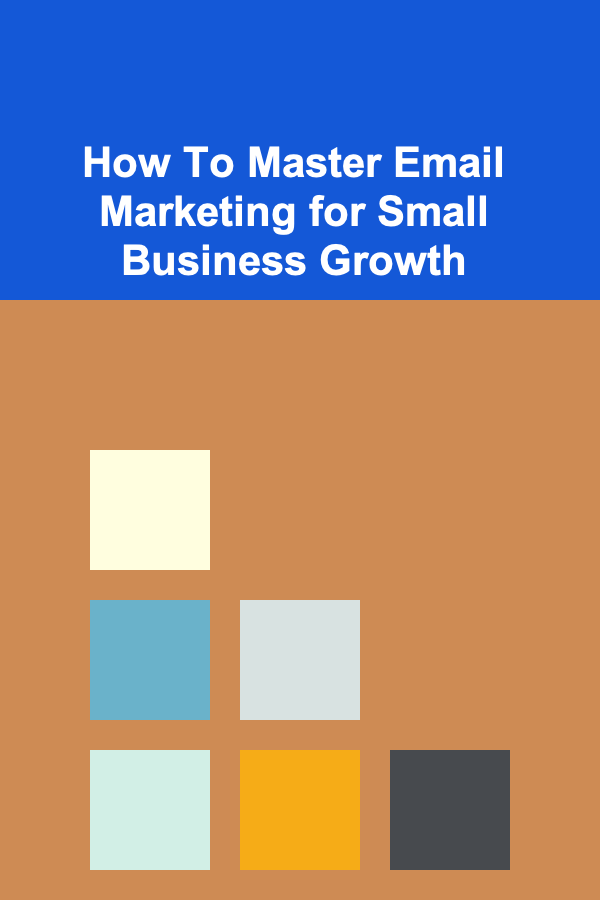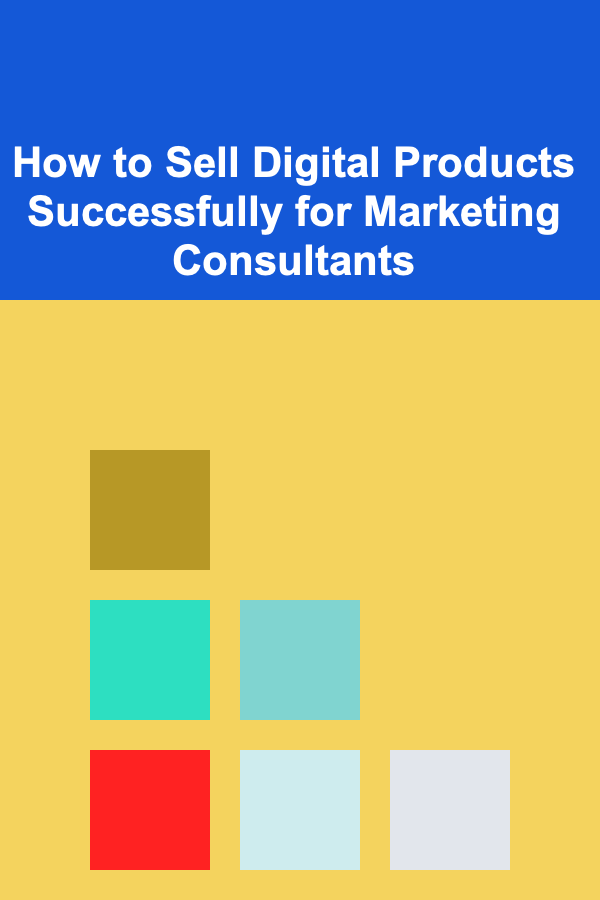
How To Master Email Marketing for Small Business Growth
ebook include PDF & Audio bundle (Micro Guide)
$12.99$8.99
Limited Time Offer! Order within the next:

In the vast, ever-evolving landscape of digital marketing, where trends come and go with dizzying speed, one channel has consistently stood the test of time, proving its enduring power and unmatched return on investment (ROI): email marketing. For small businesses, often operating with limited budgets and stretched resources, mastering email marketing isn't just an option; it's a strategic imperative. It's the digital equivalent of having a direct, personal line to your most valuable asset: your customers and prospects.
Unlike social media, where algorithms dictate who sees your content, or paid ads, which cease to deliver once your budget runs out, email offers unparalleled direct access. You own your email list; it's a proprietary asset that grows in value with every new subscriber. This deep dive will explore the comprehensive journey of mastering email marketing for small business growth, from foundational strategies to advanced optimization, ensuring you can build lasting relationships, drive sales, and foster a thriving community around your brand.
The Unassailable Case for Email Marketing in Small Business
Before we delve into the 'how,' let's firmly establish the 'why.' Why should email marketing be at the top of a small business's digital strategy?
1. Exceptional ROI
Numerous studies consistently show that email marketing delivers the highest ROI of any digital marketing channel, often cited at $38-$42 for every $1 spent. This efficiency is critical for small businesses, where every dollar needs to work harder.
2. Direct and Personal Communication
Email allows for one-to-one communication at scale. Unlike a public social media post, an email lands directly in an individual's inbox, creating a sense of personal connection. This direct line fosters trust and loyalty, which are cornerstones of small business success.
3. Ownership of Your Audience
When you build an email list, you own that list. You are not beholden to external platforms' algorithmic changes, policy shifts, or potential downtime. This direct ownership provides stability and control over your communication channels.
4. High Conversion Rates
Email subscribers have already expressed interest in your business by opting in. They are often further down the sales funnel than anonymous website visitors or social media followers, making them more likely to convert into paying customers.
5. Versatility and Adaptability
Email can serve multiple purposes: nurturing leads, promoting products, announcing news, providing customer support, soliciting feedback, and building community. Its format is flexible enough to accommodate various content types, from short promotional blasts to lengthy educational newsletters.
6. Segmentation and Personalization
Modern email marketing platforms allow for granular segmentation of your audience and deep personalization of messages. This means you can send highly relevant content to specific groups, dramatically increasing engagement and effectiveness.
Phase 1: Laying the Foundation -- Strategy and Setup
Mastering email marketing begins long before you hit 'send.' It requires strategic planning and selecting the right tools.
1. Define Your Goals
What do you want to achieve with email marketing? Be specific and make your goals SMART (Specific, Measurable, Achievable, Relevant, Time-bound).
- Increase Sales: By X% in Q3 via email promotions.
- Generate Leads: Collect Y new qualified leads per month.
- Improve Customer Retention: Reduce churn by Z% through re-engagement campaigns.
- Build Brand Awareness/Authority: Achieve a consistent open rate of A% for your weekly newsletter.
- Drive Website Traffic: Send B% of subscribers to specific blog posts or product pages.
Clearly defined goals will guide all subsequent decisions, from content strategy to metric analysis.
2. Understand Your Audience (Buyer Personas)
Who are you talking to? Create detailed buyer personas for your ideal customers. Consider their demographics, psychographics, pain points, motivations, online behavior, and communication preferences. The more you know about your audience, the better you can tailor your email content to resonate with them.
3. Choose the Right Email Marketing Platform (ESP)
Your ESP is the backbone of your email marketing efforts. For small businesses, key considerations include ease of use, features, pricing, scalability, and customer support.
- Mailchimp: Popular for its user-friendly interface and generous free tier for small lists, making it excellent for beginners. Offers good automation and segmentation.
- ConvertKit: Favored by creators, bloggers, and small e-commerce businesses for its robust automation, tagging, and landing page builders. Focuses on nurturing and selling.
- ActiveCampaign: A more advanced option, offering powerful marketing automation, CRM capabilities, and sales automation. Great for businesses looking for sophisticated lead nurturing and sales pipeline integration.
- Constant Contact: Known for its ease of use, strong event marketing features, and good support. Often preferred by businesses that host workshops or events.
- MailerLite: Offers excellent features (automation, landing pages, segmentation) at a competitive price, making it a strong contender for budget-conscious small businesses seeking more than just basic sending.
Evaluate each based on your specific goals, budget, and technical comfort level. Most offer free trials, so test them out!
4. Ensure Legal Compliance (CAN-SPAM, GDPR, CASL)
Sending unsolicited emails is not only ineffective but also illegal in many jurisdictions. Compliance is non-negotiable.
- CAN-SPAM Act (USA): Requires clear identification of sender, a physical address, a clear unsubscribe mechanism, and no misleading subject lines.
- GDPR (General Data Protection Regulation - EU): Requires explicit consent to collect and process personal data, easy data access/deletion, and clear privacy policies. Even if your business isn't in the EU, if you have EU subscribers, GDPR applies.
- CASL (Canada's Anti-Spam Legislation): Similar to GDPR, requiring explicit consent (opt-in) for commercial electronic messages.
Always use double opt-in (subscribers confirm their subscription via an email link) to ensure consent and reduce spam complaints. Provide a clear unsubscribe link in every email. Be transparent about how you collect and use data in your privacy policy.
Phase 2: Building Your List -- The Lifeblood of Email Marketing
A high-quality email list is your most valuable marketing asset. Focus on quality over quantity; 100 engaged subscribers are better than 10,000 disengaged ones.
1. Opt-In Strategies and Forms
Make it easy and enticing for people to sign up.
- Website Pop-ups/Slide-ins: Timed pop-ups or exit-intent pop-ups can be highly effective when offering value.
- Embedded Forms: Place forms prominently in your website footer, sidebar, 'About Us' page, and blog posts.
- Dedicated Landing Pages: Create specific landing pages for your lead magnets (see below) to capture email addresses.
- Checkout Process Integration: For e-commerce, offer an opt-in checkbox during checkout (ensure it's not pre-checked).
- Social Media: Use calls-to-action on your social profiles to direct followers to your sign-up form. Consider running lead-gen ads on platforms like Facebook.
- Offline Collection: If you have a physical store, collect emails at the point of sale (e.g., iPad sign-up form, business card drop-off with clear consent).
2. The Power of Lead Magnets
Don't just ask for an email; offer something valuable in return. A lead magnet incentivizes sign-ups and positions you as an authority.
- Ebooks or Guides: In-depth resources on a topic relevant to your niche.
- Checklists or Worksheets: Actionable tools that help solve a specific problem.
- Webinars or Masterclasses: Live or pre-recorded educational sessions.
- Exclusive Discounts/Coupons: Particularly effective for e-commerce (e.g., "Get 10% off your first purchase!").
- Free Trials or Samples: For software or physical products.
- Quizzes or Assessments: Interactive content that provides personalized results in exchange for an email.
- Templates or Resource Kits: Ready-to-use assets for your audience.
Ensure your lead magnet is high-quality, genuinely useful, and directly related to your core business offering.
3. Ethical List Building
Never buy email lists. They are ineffective, often contain disengaged or fake addresses, and can severely damage your sender reputation, leading to lower deliverability and being blacklisted.
Focus on organic, permission-based list growth. This ensures your subscribers are genuinely interested in what you have to offer, leading to higher engagement and better results.
Phase 3: Crafting Compelling Content -- What to Send
Once you have subscribers, the challenge is to keep them engaged. This requires sending relevant, valuable, and well-crafted emails.
1. Segmentation: The Key to Relevance
Sending the same email to everyone on your list is a recipe for disengagement. Segmentation divides your list into smaller, more specific groups based on shared characteristics or behaviors.
- Demographics: Location, age, gender (if relevant).
- Purchase History: Past purchases, total spend, product categories bought.
- Engagement Level: Active (opens/clicks frequently), inactive (rarely engages), new subscribers.
- Interests: Based on which lead magnet they opted in for, or which content they clicked on.
- Customer Status: New lead, first-time buyer, repeat customer, VIP, abandoned cart.
Examples: Send a special offer on dog food to customers who have previously bought dog supplies. Send educational content about advanced photography techniques to those who downloaded your guide on DSLR basics.
2. Personalization: Beyond the First Name
Personalization goes beyond just using a subscriber's first name. It involves tailoring the entire email experience based on their data.
- Dynamic Content: Show different product recommendations based on past purchases or browsing history.
- Location-Based Offers: Promote in-store events to subscribers in a specific geographic area.
- Behavioral Triggers: Send a follow-up email after a user clicks on a certain link or views a specific product multiple times.
- Lifecycle Stage: Tailor content based on whether they're a new lead, a first-time buyer, or a loyal customer.
3. Subject Lines: Your Email's First Impression
The subject line is the gatekeeper to your email. It must grab attention and compel the recipient to open. Aim for clarity, curiosity, urgency, or value.
- Clarity: "Your Order #12345 Has Shipped!"
- Curiosity: "Did You See What We Just Launched?"
- Urgency/Scarcity: "Last Chance: 20% Off Ends Tonight!"
- Value Proposition: "Unlock Your Potential: Free Ebook Inside"
- Personalization: "John, Here's That Tool You Asked For"
- Emojis: Use sparingly and thoughtfully to stand out.
Keep them concise (around 30-50 characters is a good target for mobile readability) and avoid spammy language ("FREE MONEY!!!" or excessive capitalization).
4. Email Body: Engaging and Actionable Content
Once opened, your email needs to deliver on the subject line's promise and guide the reader towards your goal.
- Clear Value Proposition: Why should the reader care? What's in it for them?
- Concise and Readable: Use short paragraphs, bullet points, and bold text to break up content. People skim emails.
- Visuals: Incorporate high-quality images, GIFs, or even embedded videos (or links to videos) to enhance engagement. Ensure they are optimized for quick loading.
- Storytelling: People connect with stories. Share customer success stories, behind-the-scenes glimpses, or the journey of your products.
- Strong Call-to-Action (CTA): Every email should have a single, clear primary CTA. Make it stand out with a button, use action-oriented language (e.g., "Shop Now," "Learn More," "Download Your Guide"), and place it prominently.
- Mobile Responsiveness: A vast majority of emails are opened on mobile devices. Ensure your emails look good and function well on all screen sizes.
5. Types of Emails to Send
A healthy email marketing strategy involves a mix of different email types.
- Welcome Series (Crucial!): An automated sequence sent to new subscribers. Introduce your brand, set expectations, offer a quick win (discount/free resource), and encourage first action. Typically 3-5 emails over a week.
- Promotional/Sales Emails: Announce new products, sales, discounts, or special offers. These are often the direct revenue drivers.
- Newsletters: Regular (weekly/monthly) emails providing value: blog summaries, industry news, tips, behind-the-scenes content, curated resources. Focus on building rapport and authority, not just selling.
- Transactional Emails: Order confirmations, shipping updates, password resets. While not primarily marketing, these have high open rates. Leverage them by including relevant product recommendations or links to your social media.
- Re-engagement/Win-back Emails: Sent to inactive subscribers to try and re-ignite their interest before removing them from your list.
- Abandoned Cart Sequences: Automated reminders for users who added items to their cart but didn't complete the purchase. Often highly effective.
- Educational/Nurturing Emails: Provide valuable content to move leads down the funnel, addressing pain points and showcasing your expertise.
- Customer Feedback/Review Requests: Ask customers to review products or provide feedback on their experience.
Phase 4: Automation and Nurturing -- Working Smart, Not Just Hard
Email automation is a game-changer for small businesses, allowing you to deliver timely, relevant messages without manual effort. It turns leads into customers and customers into loyal advocates.
1. The Power of Workflows and Sequences
Automation workflows are predefined series of emails triggered by specific user actions or events. They allow you to scale your personalization and provide a consistent customer journey.
- Welcome Sequence: As mentioned, this is paramount. When someone signs up, immediately send a welcome email, followed by educational content and an offer.
- Abandoned Cart Sequence: If a user leaves items in their cart, send a reminder within an hour, a follow-up with a small incentive (e.g., free shipping) 24 hours later, and a final reminder.
- Post-Purchase Follow-up: Thank customers, provide tracking info, offer related products, or ask for a review after a set period.
- Re-engagement Campaign: If a subscriber hasn't opened an email in 60 or 90 days, send a series of emails to check if they still want to hear from you. If not, remove them to keep your list healthy.
- Lead Nurturing for Non-Buyers: For leads who downloaded a specific resource but haven't purchased, send a series of emails addressing their needs, showcasing relevant products/services, and building trust.
- Birthday/Anniversary Emails: A personalized touch with a special offer can build loyalty.
2. Mapping the Customer Journey
Before setting up complex automations, map out your typical customer journey. Identify key touchpoints and opportunities to send relevant emails. For example:
- Awareness: User finds your website/social media, signs up for a lead magnet. -> Welcome series.
- Consideration: User browses products, adds to cart. -> Abandoned cart sequence.
- Decision: User makes a purchase. -> Post-purchase series.
- Retention: User has purchased, hasn't bought in a while. -> Re-engagement or loyalty campaign.
Automations allow you to put your marketing on autopilot, freeing up your time while still delivering highly effective communication.
Phase 5: Deliverability and Reputation -- Ensuring Your Emails Land
It doesn't matter how good your emails are if they land in the spam folder. Deliverability is crucial and is heavily influenced by your sender reputation.
1. Understand Sender Reputation
Your sender reputation is like a credit score for your email sending. Internet Service Providers (ISPs) like Gmail, Outlook, and Yahoo assign a score based on your sending habits. A good score means your emails are more likely to reach the inbox; a bad score means they're likely to be marked as spam.
2. Key Factors Affecting Deliverability
- List Hygiene: Regularly clean your list. Remove inactive subscribers, hard bounces (permanent delivery failures), and spam complaints. Sending to an unengaged or invalid list signals to ISPs that you're a spammer.
- Engagement: ISPs monitor how recipients interact with your emails (opens, clicks, replies). High engagement boosts your reputation; low engagement (or worse, marking as spam) hurts it.
- Authentication: Set up SPF (Sender Policy Framework), DKIM (DomainKeys Identified Mail), and DMARC (Domain-based Message Authentication, Reporting & Conformance). These technical configurations verify that emails are genuinely from your domain, preventing spoofing and improving trust with ISPs. Your ESP will guide you on this.
- Sending Consistency: Send emails regularly but not excessively. Erratic sending patterns can raise red flags.
- Avoiding Spam Triggers:
- Excessive capitalization and exclamation points.
- Spammy keywords (e.g., "free," "winner," "cash," "guarantee" -- use with care).
- Poorly coded HTML, or emails that are just one large image.
- Broken links.
- Lack of clear unsubscribe option.
- IP Warming: If you're a new sender or using a new ESP, gradually increase your sending volume over several weeks. This builds your reputation with ISPs slowly rather than triggering spam filters by sending a huge volume suddenly.
3. Monitor Your Metrics
Keep a close eye on bounce rates and spam complaint rates. A high bounce rate indicates a poor list, and even a small percentage of spam complaints (e.g., over 0.1%) can severely damage your reputation.
Phase 6: Analysis and Optimization -- Continuously Improving
Email marketing is not a set-it-and-forget-it strategy. Continuous monitoring, testing, and optimization are essential for maximizing results.
1. Key Metrics to Track
Your ESP will provide dashboards and reports. Focus on these core metrics:
- Open Rate (OR): The percentage of recipients who opened your email. Indicates subject line effectiveness and sender reputation. Formula: (Emails Opened / Emails Delivered) * 100.
- Click-Through Rate (CTR): The percentage of recipients who clicked on a link within your email. Indicates content relevance and CTA effectiveness. Formula: (Clicks / Emails Delivered) * 100.
- Conversion Rate: The percentage of recipients who completed a desired action (e.g., made a purchase, filled a form) after clicking a link in your email. This is your ultimate ROI metric. Formula: (Conversions / Emails Delivered) * 100.
- Bounce Rate: The percentage of emails that couldn't be delivered. Divided into hard bounces (permanent failure) and soft bounces (temporary issue). High hard bounces indicate a poor list.
- Unsubscribe Rate: The percentage of recipients who opted out. While some unsubscribes are normal, a sudden spike can indicate content irrelevance or over-sending.
- Spam Complaint Rate: The percentage of recipients who marked your email as spam. Aim for as close to 0% as possible.
- Overall ROI: Calculate the revenue generated from email campaigns versus the cost of your ESP and time invested.
2. A/B Testing (Split Testing)
A/B testing involves sending two different versions of an email (A and B) to a small segment of your audience to see which performs better, then sending the winning version to the rest of your list. Test one variable at a time:
- Subject Lines: The most common and impactful A/B test.
- Call-to-Action (CTA): Text, color, placement, button vs. text link.
- Email Content: Short vs. long, different images, different messaging.
- Send Time/Day: When are your subscribers most engaged?
- From Name: Your company name vs. a person's name.
Small, iterative tests over time can lead to significant improvements in your campaign performance.
3. Continuous Iteration
Analyze your results, identify what worked and what didn't, and adjust your strategy accordingly. Don't be afraid to experiment. Your audience's preferences may evolve, and your email strategy should too.
Phase 7: Advanced Strategies & Future Trends for Small Businesses
Once you've mastered the fundamentals, consider these advanced tactics to further boost your small business's growth through email.
1. CRM Integration
Integrate your email marketing platform with your Customer Relationship Management (CRM) system (if you use one). This creates a unified view of your customer, allowing for even more sophisticated segmentation, personalization, and sales follow-up.
2. Leveraging User-Generated Content (UGC)
Encourage customers to share photos, videos, or testimonials of your products/services and feature them in your emails. UGC builds social proof, trust, and community, often outperforming professional marketing content.
3. Interactive Email Elements (AMP for Email)
Some ESPs now support AMP for Email, which allows for interactive elements directly within the email (e.g., carousels, forms, live updates, quizzes). While still relatively new and complex, this can significantly boost engagement for specific campaigns.
4. AI in Email Marketing
Artificial intelligence is increasingly being integrated into email platforms. For small businesses, this can mean:
- AI-generated Subject Lines: Tools that suggest high-performing subject lines based on your content and industry.
- Predictive Personalization: AI analyzes user behavior to recommend the most relevant products or content to individual subscribers.
- Optimal Send Time: AI algorithms can determine the best time to send an email to each individual subscriber for maximum engagement.
These features can help small businesses punch above their weight without needing a data science team.
5. SMS Integration
For urgent promotions, transactional updates, or last-minute reminders, integrating SMS into your email strategy can be powerful. Always obtain explicit consent for SMS messages, as they are highly personal and subject to strict regulations.
6. Email & Social Media Synergy
Don't treat email and social media as separate silos. Promote your email list on social channels, and share snippets of your email content (e.g., a quote from your newsletter) on social media. Conversely, use email to drive traffic to your social profiles or encourage sharing of your content.
Common Challenges and How to Overcome Them
While powerful, email marketing isn't without its hurdles. Being aware of them allows you to proactively address them.
1. Low Open Rates
Solution: Focus on compelling subject lines, A/B test them. Improve sender reputation. Segment your list to send more relevant content. Clean your list of unengaged subscribers.
2. Low Click-Through Rates
Solution: Ensure your email content delivers on the subject line's promise. Make your CTA clear, prominent, and compelling. Ensure mobile responsiveness. Segment your list to send highly relevant offers/content.
3. High Unsubscribe/Spam Complaint Rates
Solution: Review your content for relevance and value. Are you sending too often? Are you being too salesy? Ensure easy unsubscribe access. Double-check your list acquisition methods to ensure genuine consent. Re-engage or remove inactive subscribers.
4. List Decay
Solution: Natural list decay (around 22.5% per year) means you need continuous list building efforts. Regularly review and remove inactive subscribers to maintain list health.
5. Content Creation Fatigue
Solution: Repurpose content (blog posts into email snippets, videos into text summaries). Create templates for different email types. Plan content in advance with an editorial calendar. Consider guest contributors or user-generated content.
6. Technical Overwhelm
Solution: Start simple. Master the basics (list building, welcome series, newsletters) before diving into complex automations. Leverage your ESP's customer support and learning resources. Many small businesses find immense value in focusing on the core rather than all advanced features.
The Long-Term Vision for Small Business Growth
Mastering email marketing for your small business is a journey, not a destination. It demands consistent effort, an empathetic understanding of your audience, and a willingness to learn and adapt.
Think of your email list as your private community. Nurture it with valuable content, communicate openly, and respect their inbox. When done correctly, email marketing transforms from a mere promotional tool into a powerful relationship-building engine. It enables you to:
- Build a Loyal Customer Base: Engaged subscribers are more likely to become repeat customers and brand advocates.
- Drive Repeat Business: Automated campaigns can remind customers of past purchases, suggest complementary products, and offer loyalty incentives.
- Gather Invaluable Feedback: Email is a direct channel for surveys, reviews, and customer service interactions, providing insights for business improvement.
- Weather Economic Storms: A strong direct channel reduces reliance on volatile paid advertising or unpredictable social media algorithms.
- Increase Lifetime Customer Value (LTV): By staying connected and continually offering value, you increase the long-term revenue generated by each customer.
For small businesses vying for attention in a crowded marketplace, email marketing offers a unique blend of affordability, directness, and measurable impact. It's the digital handshake that builds trust, the consistent touchpoint that fosters loyalty, and the reliable channel that directly fuels sustainable growth. Embrace it, master it, and watch your small business thrive.

How to Keep Your Home's Lawn Irrigation System Running Smoothly
Read More
How to Sell Digital Products Successfully for Marketing Consultants
Read More
How to Track Your Investments and Monitor Performance
Read More
How to Invest in Climate-Resilient Agriculture
Read More
How To Get Better at Valorant
Read More
How to Create a Therapy Session Planner for Neurodivergent Clients
Read MoreOther Products

How to Keep Your Home's Lawn Irrigation System Running Smoothly
Read More
How to Sell Digital Products Successfully for Marketing Consultants
Read More
How to Track Your Investments and Monitor Performance
Read More
How to Invest in Climate-Resilient Agriculture
Read More
How To Get Better at Valorant
Read More